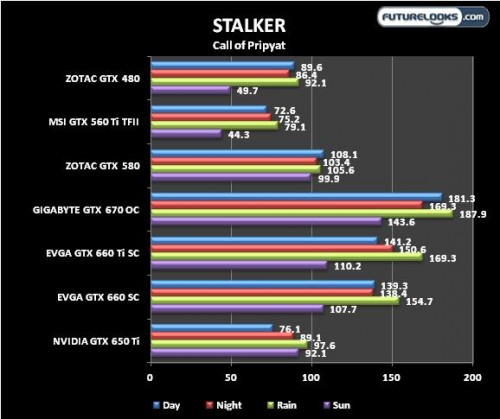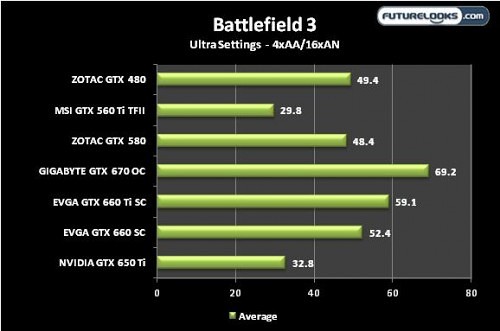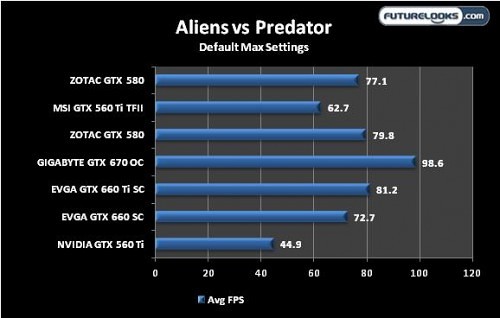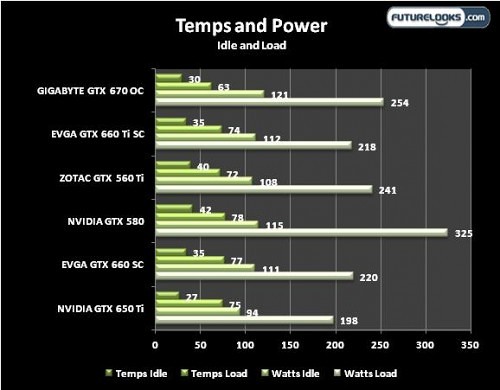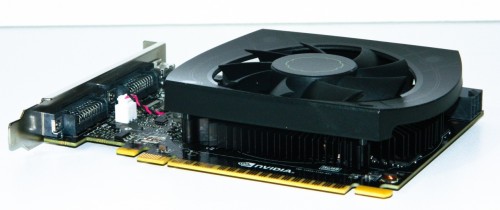Stalker Call of Pripyat
Yes, these scores are correct. I ran the benchmark a few more times just to make sure it was running correctly. Again, more memory resources help make the difference but having a high clocked GPU makes up some ground.
Battlefield 3
The GTX 650 Ti might not produce the highest average here in Ultra settings, but it still does well given its resources. If you turn the settings to High or even Medium, you’ll see average frame rates in the 40s with smoother game play as promised by NVIDIA. Turning depth of field down or off adds even more frames for even more improved game play. If you overclock it, you should add a few more.
Aliens vs Predator
And, finally, AVP uses a slightly older game engine but still highly detailed textures. If you’re playing these types of games, this card is the minimum you’ll want to run for best results. Many of today’s RPG games will score similarly.
Thermal, Power, and Noise
I used both ASUS GPU Tweak and EVGA Precision X to monitor temps. Unigine Heaven 3.0 was used repeatedly to heat the GPU up to see what kind of temps we can expect from serious game titles. Keep in mind this card has a reference GPU cooler which partners have to match or exceed. As you saw in the partners section, they’ve all decided to exceed. Some by quite a bit.
Naturally, the low powered GTX 650 Ti idles at a very cool at 27C. However, when the benchmark runs over and over heating up things, the GPU hit 75C at all times even when running a lower end benchmark. The reference fan just seems to max out though it can be heard at around 34dB. Again, expect partner cards to cool much better.
Final Thoughts
The NVIDIA Kepler GPU continues to surprise in a big way even as the PCB foot print shrinks. While the GTX 650 Ti might look tiny, it has a big heart. The GTX 650 Ti design makes efficient use of its limited resources producing playable frame rates at 1080p as promised. Naturally, if graphical details aren’t a priority or if you have a lower resolution display, the frames rates will be higher.
The great thing is that many partner cards feature is 2GB GDDR5 which means better frame rates even with high game settings and larger textures. However, if eye candy is very important, we would definitely recommend the the next step up to a GTX 660 or 660 Ti if you can afford it. But you wouldn’t be looking at this review if that was an option right?
NVIDIA’s own GTX 650 Ti launches for $149.99 US while the partner cards offer aftermarket and overclocked options in addition to the increased memory. Pricing is as follows: ASUS GTX650Ti-1GD5 $154.99, GIGABYTE GV-N65TOC-1GI $159.99, Galaxy 65IGH8DL7AXX $159.99, EVGA SSC 01G-P4-3652-KR $159.99, MSI N650Ti PE 1GD5/OC $159.99, and ZOTAC ZT-61102-10M $169.99 to give you idea. Plus, at launch, North American board partners are bundling Assassins Creed 3 with the card which makes video cards based on this GPU an even greater value.
Now that we’ve seen the last Kepler GPU for 2012, we’re wondering how NVIDIA can top Kepler? If their innovation streak continues, we can’t wait to see what’s next. And right now, their innovation can give you 1080p resolutions with reasonable frame rates at moderate detail settings at an affordable price.
Pros
- Great 1080p budget gaming solution
- Small foot print and 100 watt TDP
- Still supports up to 4 displays (on select partner cards)
- Double digit (14 fps) increases when overclocked
Cons
- Reference cooling solution could be better
Overall Rating: 9.0 / 10.0

Help Us Improve Our Reviews By Leaving a Comment Below!


